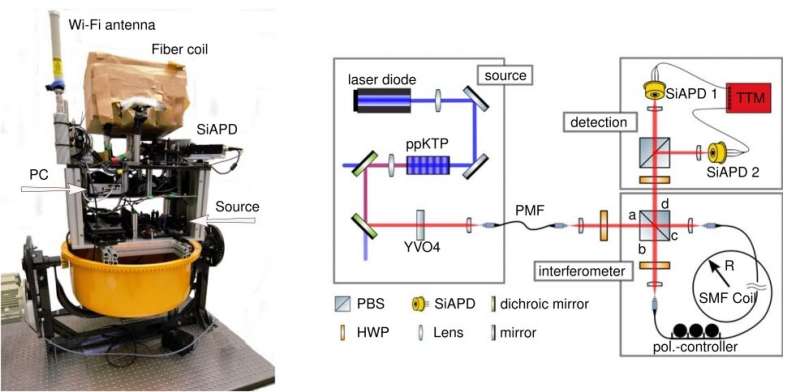May 16, 2019 feature
Entangled-photon gyroscope overcomes classical limit

Fiber optic gyroscopes, which measure the rotation and orientation of airplanes and other moving objects, are inherently limited in their precision when using ordinary classical light. In a new study, physicists have experimentally demonstrated for the first time that using entangled photons overcomes this classical limit, called the shot-noise limit, and achieves a level of precision that would not be possible with classical light.
The physicists, led by Matthias Fink and Rupert Ursin at the Austrian Academy of Sciences and the Vienna Center for Quantum Science and Technology, have published a paper on the entanglement-enhanced fiber-optic gyroscope in a recent issue of the New Journal of Physics.
"We have demonstrated that the generation of entangled photons has reached a level of technical maturity that enables us to perform measurements with sub-shot noise accuracy in harsh environments," Fink told Phys.org.
Fiber-optic gyroscopes (FOGs) are similar to the familiar spinning gyroscopes often sold as toys, as both types of gyroscopes measure an object's rotation. However, the two devices operate using different mechanisms: FOGs have no moving parts, and instead make their measurements using light.
Whereas spinning gyroscopes were developed in the 19th century, FOGs were introduced in the late 1970s and are based on the Sagnac effect that was first observed by Georges Sagnac in 1913. At the time, Sagnac was hoping to detect the ether medium through which light was thought to propagate, but instead his experiment became one of the fundamental tests in support of the theory of relativity.
The Sagnac effect arises when two light beams travel around a ring in different directions in an interferometer. When the interferometer is at rest, both beams take the same amount of time to traverse the ring, but when the interferometer begins to rotate, the beam moving around the ring in the direction of the rotation will travel a longer distance, and therefore take more time, to reach the detector than the other beam. This time difference results in a phase difference between the two beams.
The precision with which a FOG can measure this phase difference determines the precision of the overall rotation measurement. A FOG's precision is limited by several sources of noise, with the major contributor being shot noise. Shot noise arises due to the quantization of the photons. As the individual photons pass through the device, their discrete nature means that the flow is not perfectly smooth, resulting in white noise. Although the shot noise can be decreased by increasing the power (the rate of photons passing through), a higher power increases other types of noise, resulting in a trade-off.
To overcome the shot noise limit, in the new study the physicists used pairs of entangled photons that are in a superposition of the two modes, so that both entangled photons effectively travel through the ring in both directions. The entanglement results in a significant reduction in the de Broglie wavelength of the photons, which in turn leads to a precision that exceeds the shot noise limit, and equivalently, exceeds the best precision possible using classical light.
In its current state, the new FOG is not yet competitive with commercial (classical) FOG devices due to its lower power, which is a consequence of the detectors used. The researchers expect that advances in detector technology and brighter photon sources will make the entangled-photon FOG feasible for applications in the near future. Overall, they hope that the current results represent an important first step toward achieving the ultimate sensitivity limits in fiber-optic gyroscopes.
"An interesting question is to what extent other noise sources besides the shot noise can be reduced or compensated by using optimized photonic states," Fink said. "The answers to such questions can be experimentally assessed at intensities where such effects become significant."
More information: Matthias Fink et al. "Entanglement-enhanced optical gyroscope." New Journal of Physics. DOI: 10.1088/1367-2630/ab1bb2
Journal information: New Journal of Physics
© 2019 Science X Network




















